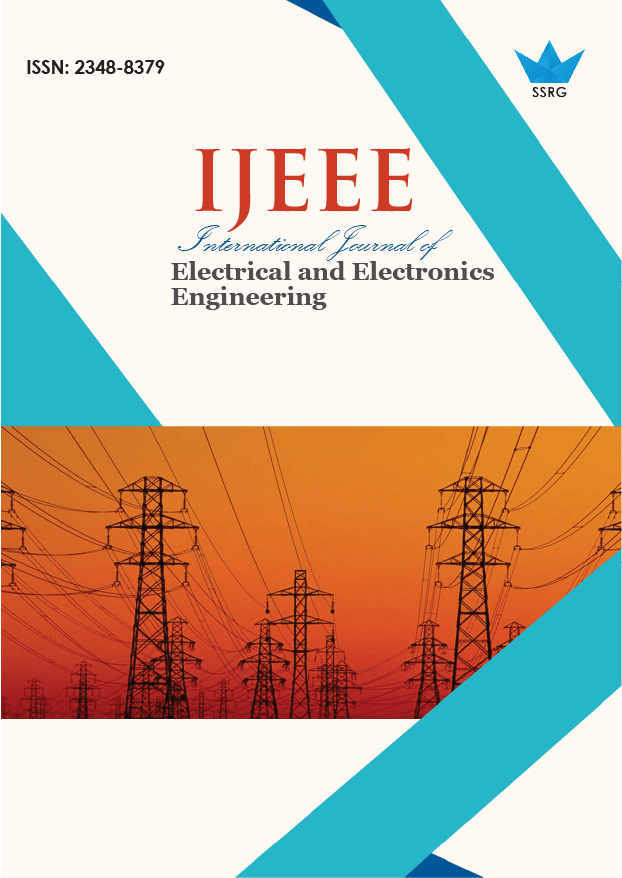The Neural Logging of Taste: Studying Gustation Via Surface EEG & The Scope of Replicative Rendering

| International Journal of Electrical and Electronics Engineering |
| © 2025 by SSRG - IJEEE Journal |
| Volume 12 Issue 3 |
| Year of Publication : 2025 |
| Authors : Angel Swastik Duggal, Praveen Kumar Malik, Rajesh Singh, Anita Gehlot |
How to Cite?
Angel Swastik Duggal, Praveen Kumar Malik, Rajesh Singh, Anita Gehlot, "The Neural Logging of Taste: Studying Gustation Via Surface EEG & The Scope of Replicative Rendering," SSRG International Journal of Electrical and Electronics Engineering, vol. 12, no. 3, pp. 145-154, 2025. Crossref, https://doi.org/10.14445/23488379/IJEEE-V12I3P115
Abstract:
The domain of taste electrophoresis has conventionally relied on physical sensory evaluation as the conventional logging technique for taste parameters. This paper presents a multi-perspective analysis of the neural aspect of taste-evoked potentials using custom-built low-cost hardware. Using biomedical means, the work proposes alternate means to bridge the gap between sensation and stimulation, bypassing subjective bias in testing by directly logging neural responses. There are various techniques with which the sensation of taste can be identified, surface EEG being a cheaper, non-invasive option among them. To study the neural response of taste, a 4-channel EEG kit was built using low-cost analog front ends. A gustatory galvanic stimulation circuit was also built to deliver taste-eliciting electrical impulses. The circuit was then fitted into a 3D-designed spoon for easy impulse delivery. The EEG response was then fed into an LSTM for further classification. The accuracy of the model was rounded off to 68%. The surface EEG data, although non-stationary in nature, can be plugged into AI-ML-based algorithms for analysis and event-window classification. For better results, using higher-spec hardware with more channels and higher sensitivity could significantly overturn the technique into a reliable means of logging accurate taste electro stimuli.
Keywords:
Augmented reality, Biosignals, Electrogustometry, Galvanic taste, Nerve stimulation.
References:
[1] Johann Georg Sulzer, New Theory of Pleasures, 1767.
[Google Scholar]
[2] Ernest Dzendole, “Electrical Stimulation of Single Human Taste Papillae,” Perceptual and Motor Skills, vol. 14, no. 2, pp. 303-317, 1962.
[CrossRef] [Google Scholar] [Publisher Link]
[3] Letao Wang et al., “Artificial Taste: Advances and Innovative Applications in Healthcare,” Applied Sciences, vol. 15, no. 2, 2025.
[CrossRef] [Google Scholar] [Publisher Link]
[4] Goal 9 | Department of Economic and Social Affairs, 2023. [Online]. Available: https://sdgs.un.org/goals/goal9
[5] Antonietta Canna et al., “Intensity-Related Distribution of Sweet and Bitter Taste Fmri Responses in the Insular Cortex,” Human Brain Mapping, vol. 40, no. 12, pp. 3631-3646, 2019.
[CrossRef] [Google Scholar] [Publisher Link]
[6] Sara Ponticorvo et al., “Sex Differences in the Taste-Evoked Functional Connectivity Network,” Chemical Senses, vol. 47, 2022.
[CrossRef] [Google Scholar] [Publisher Link]
[7] E Porcu et al., “Information-Based Taste Maps in Insular Cortex are Shaped by Stimulus Concentration,” bioRxiv, 2019.
[CrossRef] [Google Scholar] [Publisher Link]
[8] Roberts Carl A et al., “A Systematic Review and Activation Likelihood Estimation Meta-Analysis of fMRI Studies on Sweet Taste in Humans,” The Journal of Nutrition, vol. 150, no. 6, pp. 1619-1630, 2020.
[CrossRef] [Google Scholar] [Publisher Link]
[9] Ismi Abidi, Omar Farooq, and M M S Beg, “Sweet and Sour Taste Classification Using EEG Based Brain Computer Interface,” 2015 Annual IEEE India Conference, New Delhi, India, 2015.
[CrossRef] [Google Scholar] [Publisher Link]
[10] Camilla Arndal Andersen et al., “EEG Discrimination of Perceptually Similar Tastes,” Journal of Neuroscience Research, vol. 97, no. 3, pp. 241-252, 2019.
[CrossRef] [Google Scholar] [Publisher Link]
[11] Kalyana Sundaram Chandran, and Marichamy Perumalsamy, “EEG-Taste Classification through Sensitivity Analysis,” International Journal of Electrical Engineering & Education, vol. 60, no. 1, pp. 1649-1661, 2019.
[CrossRef] [Google Scholar] [Publisher Link]
[12] Marina Domracheva, and Sofya Kulikova, “EEG Correlates of Perceived Food Product Similarity in a Cross-Modal Taste-Visual Task,” Food Quality and Preference, vol. 85, 2020.
[CrossRef] [Google Scholar] [Publisher Link]
[13] Hengyang Wang et al., “Quantitatively Recognizing Stimuli Intensity of Primary Taste Based on Surface Electromyography,” Sensors, vol. 21, no. 21, 2021.
[CrossRef] [Google Scholar] [Publisher Link]
[14] You Wang et al., “Qualitative Recognition of Primary Taste Sensation Based on Surface Electromyography,” Sensors, vol. 21, no. 15, 2021.
[CrossRef] [Google Scholar] [Publisher Link]
[15] Ben Wu et al., “Investigating the Influence of Different Umami Tastants on Brain Perception Via Scalp Electroencephalogram,” Journal of Agricultural and Food Chemistry, vol. 70, no. 36, pp. 11344-11352, 2022.
[CrossRef] [Google Scholar] [Publisher Link]
[16] Shuo Zhao et al., “Basic Taste Intensity Recognition based on sEMG and EEG Signals,” 2022 China Automation Congress, Xiamen, China, pp. 5437-5441, 2022.
[CrossRef] [Google Scholar] [Publisher Link]
[17] Aliya et al., “Evaluation of Flavor Perception of Strong-Aroma Baijiu Based on Electroencephalography (EEG) and Surface Electromyography (EMG) Techniques,” Food Chemistry, vol. 472, 2025.
[CrossRef] [Google Scholar] [Publisher Link]
[18] Kazuma Aoyama et al., “Galvanic Tongue Stimulation Inhibits Five Basic Tastes Induced by Aqueous Electrolyte Solutions,” Frontiers in Psychology, vol. 8, 2017.
[CrossRef] [Google Scholar] [Publisher Link]
[19] Kazuma Aoyama et al., “Taste Controller: Galvanic Chin Stimulation Enhances, Inhibits, and Creates Tastes,” Acm Siggraph 2018 Emerging Technologies, pp. 1-2, 2018.
[CrossRef] [Google Scholar] [Publisher Link]
[20] Kazuma Aoyama, “Galvanic Taste Stimulation Method for Virtual Reality and Augmented Reality,” Human Interface and the Management of Information. Designing Information, pp. 341-349, 2020.
[CrossRef] [Google Scholar] [Publisher Link]
[21] Hiromi Nakamura, Makoto Mizukami, and Kazuma Aoyama, “Method of Modifying Spatial Taste Location through Multielectrode Galvanic Taste Stimulation,” IEEE Access, vol. 9, pp. 47603-47614, 2021.
[CrossRef] [Google Scholar] [Publisher Link]
[22] Hiromi Nakamura et al., “Anodal Galvanic Taste Stimulation to the Chin Enhances Salty Taste of Nacl Water Solution,” Journal of Robotics and Mechatronics, vol. 33, no. 5, pp. 1128-1134, 2021.
[CrossRef] [Google Scholar] [Publisher Link]

 10.14445/23488379/IJEEE-V12I3P115
10.14445/23488379/IJEEE-V12I3P115